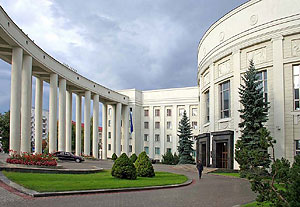Ru
|
Eng
NASB strategy to move Belarus economy to more advanced technology
10.09.2014

In the strategy to guide the development of the Belarus economy till 2030 the National Academy of Sciences of Belarus intends to suggest ways, mechanisms, and scenarios for transition to the sixth technological paradigm, the highest one, BelTA learned from Vladimir Gusakov, Chairman of the Presidium of the National Academy of Sciences of Belarus (NASB), on 10 September.
According to the source, the sixth technological paradigm is more than innovation-driven development of the country based on knowledge economy. Belarusian science is not separated from manufacturing even now. But later on science will be at the heart — all the knowledge, R&D, vision for using available resources and organizing manufacturing processes, Vladimir Gusakov said.
Vladimir Gusakov told media how the scientists see the development of the Belarus economy till 2030 in general. “The share of nano and biotechnologies, space technologies, nuclear power should grow. At present their share in the GDP is small but in the future they should be dominating. It is necessary to create conditions for the accelerated development of innovative breakthrough industries,” stressed the Chairman of the Presidium of the National Academy of Sciences of Belarus.
The plan for the strategy to develop the Belarusian economy till 2030 was presented at the session of the commission for state scientific and technical policy under the Council of Ministers on 10 September. Opening the session, Prime Minister of Belarus Mikhail Myasnikovich noted: “I would like it to be an ambitious yet thoroughly checked document that will truly shape a new economy — a knowledge economy”.
In particular, the document is supposed to offer proposals regarding the national investment policy, lists of national innovation projects for 2016-2030. The National Academy of Sciences of Belarus has shortlisted 22 projects that can be implemented using instruments of the strategy document. The projects include innovation-driven education, the China-Belarus Industrial Park, and the BelBioGrad cluster.
The idea to work out the strategy has been approved by the head of state. Similar documents are in use in the USA, Russia, and a number of European countries.
According to the source, the sixth technological paradigm is more than innovation-driven development of the country based on knowledge economy. Belarusian science is not separated from manufacturing even now. But later on science will be at the heart — all the knowledge, R&D, vision for using available resources and organizing manufacturing processes, Vladimir Gusakov said.
Vladimir Gusakov told media how the scientists see the development of the Belarus economy till 2030 in general. “The share of nano and biotechnologies, space technologies, nuclear power should grow. At present their share in the GDP is small but in the future they should be dominating. It is necessary to create conditions for the accelerated development of innovative breakthrough industries,” stressed the Chairman of the Presidium of the National Academy of Sciences of Belarus.
The plan for the strategy to develop the Belarusian economy till 2030 was presented at the session of the commission for state scientific and technical policy under the Council of Ministers on 10 September. Opening the session, Prime Minister of Belarus Mikhail Myasnikovich noted: “I would like it to be an ambitious yet thoroughly checked document that will truly shape a new economy — a knowledge economy”.
In particular, the document is supposed to offer proposals regarding the national investment policy, lists of national innovation projects for 2016-2030. The National Academy of Sciences of Belarus has shortlisted 22 projects that can be implemented using instruments of the strategy document. The projects include innovation-driven education, the China-Belarus Industrial Park, and the BelBioGrad cluster.
The idea to work out the strategy has been approved by the head of state. Similar documents are in use in the USA, Russia, and a number of European countries.
SCIENCE. TECHNOLOGY. INNOVATIONS
13.08.2024
28.06.2024
28.06.2024
25.06.2024
05.06.2024
15.05.2024
15.05.2024
26.04.2024
26.04.2024
26.04.2024













